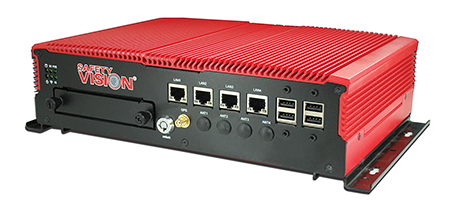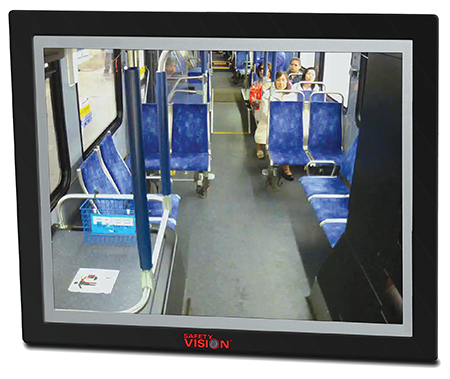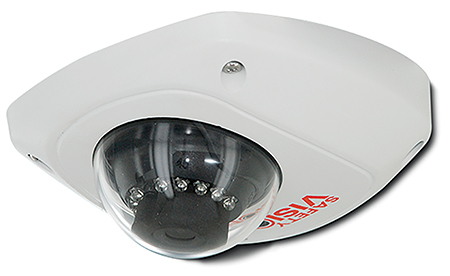
UTA secures its services with Safety Vision
By Richard Tackett
A rail fleet as big as the Utah Transit Authority’s (UTA) requires constant oversight. The agency’s TRAX light-rail system and its FrontRunner heavy-rail service combined to provide over 1.8 million rides in January 2018 alone, making the system susceptive to onboard incidents.
Despite this, the UTA had approximately 400 networked cameras in use with no networked-connected cameras on any of its fleet of 717 vehicles in 2002. Lamount Worthy, video security administrator (and new to the job in 2013), was tasked by agency leadership to expand UTA’s surveillance capabilities to encompass its entire fleet.
Initially, expansion meant adding six recording servers and increasing UTA’s server space by 200 percent. Then Worthy’s team turned its attention to outfitting its fleet.
 TRAX
TRAX
UTA established the TRAX light-rail system in 2000 to service Salt Lake County. Its service area features 50 stations and its three lines cross 45 miles and nine municipalities. The TRAX system has two types of light-rail vehicles, the Siemens SD and later the Siemens S70 low-floor models. During initial deployment of the S70 models in 2012, UTA opened competitive bidding for cameras on those vehicles. Safety Vision won the bid and outfitted 77 S70 trains with cameras, marking the beginning of a fruitful relationship.
“Before connecting with Safety Vision, we didn’t have the capability to conduct video investigations or capture video data from our trains,” Worthy says. “But it was still a young system and very small regarding how much data we could retain.”
When Worthy came to work for UTA, he took a hard look at how administrators gathered data from their cameras. Even with Safety Vision’s advanced system, data retrieval was still a manual, labor-intensive process. And because it was a manual system, there was no way to check the health of the camera system outside of data retrieval.
With that in mind, Worthy began consulting with his team at UTA about new, replacement cameras on its S70 vehicles, as well as cameras for its SD trains and the FrontRunner’s heavy-rail line.
FrontRunner
UTA introduced the FrontRunner system in 2008 as Utah’s first commuter rail line. It operates six days per week and its line encompasses 89 miles. It connects the Davis, Salt Lake, Utah and Weber counties.

is a network video recorder which supports
up to 16 cameras, 2 TB of storage and 1080p resolution.
“While we were looking to upgrade the S70 and SD vehicles’ cameras, we simultaneously started looking for cameras for the FrontRunner system,” Worthy says. “For all vehicles, we wanted high-definition cameras with microphones and Wi-Fi-enabled data retrieval, able to withstand ruggedized environments with extremely fluctuating temperatures.”
Again, Safety Vision’s proposal hit all those marks. Upon winning the RFP for the FrontRunner installation, Safety Vision created a Wi-Fi umbrella at the UTA’s Warm Springs facility – where it houses its commuter rail fleet. That umbrella enables automatic data offloading as soon as a train pulls into the facility.
Next, Safety Vision installed the RoadRecorder® 8400, a network video recorder which supports 16 cameras per unit, 2 TB of storage and 1080p resolution.
Finally, Safety Vision deployed interior 45-series and exterior 46-series cameras to the FrontRunner fleet.
 SD Overhaul
SD Overhaul
As the Frontrunner heavy-rail camera deployment progressed, UTA was simultaneously beginning the process of overhauling and refurbishing the SD100 and SD160 models in its light-rail fleet. The process is extensive and still underway.
A major part of that process involves outfitting all SD vehicles with new camera systems, and Safety Vision again won the competitive bidding process.
“We were so happy with the camera on our FrontRunner service,” Worthy says, “that we spec’d very similar cameras for the SD Overhaul Project.”
A consolidated system
Safety Vision’s Wi-Fi-enabled cameras are now outfitted on UTA’s entire heavy-rail fleet as well as all SD light-rail vehicles that have completed refurbishment.
They are also currently working on a new contract, which has the agency updating and replacing the older Safety Vision cameras on its fleet of S70 light-rail vehicles.
From the initial stages of its relationship with Safety Vision, UTA’s surveillance deployment has now grown from 400 to 3,200 network-connected cameras.

Training and installation
“Working with Safety Vision has been positive largely because of the relationship’s flexibility,” Worthy says. “We don’t have an overwhelming amount of capital for the various camera projects, so we had to save where we could save.”
Part of those savings involved UTA alone undertaking the camera installation – so it was critical that the agency’s technicians understood exactly what they were doing.
That’s where Safety Vision stepped in. They sent a certified technician to UTA to train the installers, taking about two weeks in an exhaustive course. They also helped with the first few installations and assisted in troubleshooting.
“The products are very easy to install, when you know your way around a train as well as the people from UTA,” says Justin Lindbloom, account executive at Safety Vision. “After several training classes with the installers at UTA, the agency’s team was doing an excellent job.”
“The training was top notch,” Worthy adds. “We had almost daily communication with Safety Vision. All of our crews are able to effectively maintain the cameras, and I’ve been able to process video efficiently without needing to rely on a slow manual process.”

Difference-making technology
From an incident investigation standpoint, UTA’s surveillance network has dramatically improved. Previously, in the case of an accident, UTA would rely solely on onsite investigators, witness testimony and physical evidence. Now, with automatic onboard recording and wireless data retrieval, investigators are working much more quickly and efficiently.
“Being able to accurately recreate a scene is extremely beneficial,” Worthy says. “It allows us to take appropriate measures to rectify the situation. How can we make this area safer? How can we make sure the incident doesn’t happen again? Video helps us guide that conversation in a particular and positive direction.”
Whereas UTA technicians previously had to pull hard drives to maintain cameras, the new system emails detailed status reports on recorder health. Furthermore, full wireless downloading means that UTA technicians don’t need to be onboard a vehicle to pull data – and Worthy can use back-end software to view downloaded videos.
The future
Worthy says that, now that UTA has committed to outfitting its mobile systems and fixed locations with high-definition, wireless-enabled cameras, there is no turning back for the agency.
“Our agency is always looking for what’s next,” he says. “What can we do next to enhance our data? The beautiful thing about this technology is that it’s always improving and will allow us to stay ahead of the curve.”
Worthy says he foresees UTA constantly improving its camera system as usage increases.
“These surveillance systems help UTA get to the bottom of any situation that might arise,” Lindbloom says. “We’re proud to help the agency create a safer environment for its employees and passengers.”
